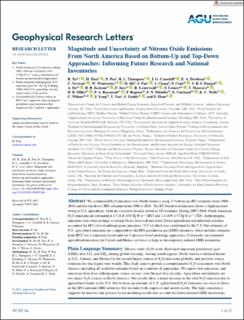Magnitude and Uncertainty of Nitrous Oxide Emissions From North America Based on Bottom-Up and Top-Down Approaches: Informing Future Research and National Inventories
Xu, Rongting; Tian, Hanqin; Pan, N.; Thompson, Rona Louise; Canadell, Josep G.; Davidson, Eric A.; Nevison, Cynthia; Winiwarter, Wilfried; Shi, H.; Pan, Shufen; Chang, J.; Ciais, Philippe; Dangal, Shree R. S.; Ito, Akihiko; Jackson, Robert B.; Joos, Fortunat; Lauerwald, Ronny; Lienert, Sebastian; Maavara, Taylor; Millet, Dylan B.; Raymond, Peter A.; Regnier, P.; Tubiello, Francesco N; Vuichard, Nicolas; Wells, Kelley C.; Wilson, Chris; Yang, J.; Yao, Y; Zaehle, Sönke; Zhou, Feng
Peer reviewed, Journal article
Published version
Permanent lenke
https://hdl.handle.net/11250/2838294Utgivelsesdato
2021Metadata
Vis full innførselSamlinger
- Publikasjoner fra Cristin - NILU [1360]
- Vitenskapelige publikasjoner [1096]
Sammendrag
We synthesized N2O emissions over North America using 17 bottom-up (BU) estimates from 1980–2016 and five top-down (TD) estimates from 1998 to 2016. The BU-based total emission shows a slight increase owing to U.S. agriculture, while no consistent trend is shown in TD estimates. During 2007–2016, North American N2O emissions are estimated at 1.7 (1.0–3.0) Tg N yr−1 (BU) and 1.3 (0.9–1.5) Tg N yr−1 (TD). Anthropogenic emissions were twice as large as natural fluxes from soil and water. Direct agricultural and industrial activities accounted for 68% of total anthropogenic emissions, 71% of which was contributed by the U.S. Our estimates of U.S. agricultural emissions are comparable to the EPA greenhouse gas (GHG) inventory, which includes estimates from IPCC tier 1 (emission factor) and tier 3 (process-based modeling) approaches. Conversely, our estimated agricultural emissions for Canada and Mexico are twice as large as the respective national GHG inventories.
